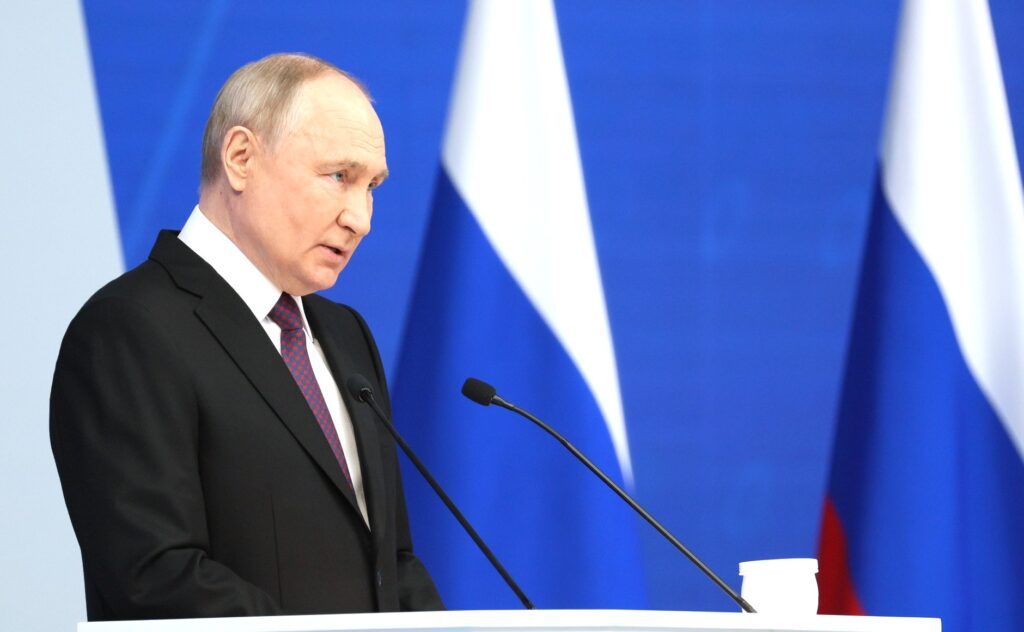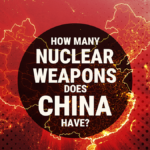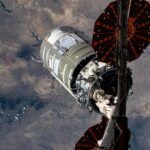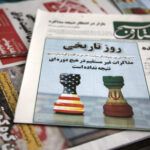Why the West should take Russia’s nuclear threats more seriously
By Giles David Arceneaux | June 12, 2024
 Russian President Vladimir Putin warned of nuclear conflict during his annual speech to the nation on February 29, 2024. On June 5, he said the West was wrong to assume Russia would never use nuclear weapons and that the Kremlin's nuclear doctrine should not be taken lightly. (Credit: Kremlin.ru)
Russian President Vladimir Putin warned of nuclear conflict during his annual speech to the nation on February 29, 2024. On June 5, he said the West was wrong to assume Russia would never use nuclear weapons and that the Kremlin's nuclear doctrine should not be taken lightly. (Credit: Kremlin.ru)
Russian nuclear threats have returned to the forefront of the war in Ukraine, but this time with a new feature: exercises involving tactical nuclear weapons.
These exercises come in response to Western powers signaling broader support for Ukraine. On April 29, for instance, French President Emmanuel Macron reaffirmed his position that France remains open to sending ground troops to Ukraine to bolster European security against Russian aggression. Shortly after, the United Kingdom’s Foreign Secretary, David Cameron, announced that the UK government would support Ukraine using UK-supplied weapons against Russian territory.
In response, Russia characterized these statements as a “completely new round of escalation of tension” and announced on May 6 that it would conduct drills simulating the use of tactical nuclear weapons, or—as Russia describes them—“non-strategic” nuclear weapons. Although these drills constitute a new kind of nuclear threat, they have been dismissed as not credible by a growing number of European countries. But the fine line between skepticism and complacency could pose significant risks for crisis stability in Europe.
Threat or bluff? Russia’s ordering of drills on May 6 mark the first public announcement of military exercises involving tactical nuclear weapons since its full-scale invasion of Ukraine in February 2022. The exercises—first conducted on May 7-9 and later expanded to include nuclear bombers on May 27-31—also included Belarus, who agreed to host Russian tactical nuclear weapons in June 2022. By overtly training with tactical nuclear weapons which are specifically designed for battlefield nuclear use and incorporating Belarus into the exercises, Russia has stepped closer to the nuclear threshold and opened new pathways for nuclear escalation.
Despite the new and explicit attention to operational exercises involving tactical nuclear weapons, however, leaders in countries ranging from Lithuania to Ukraine have joined a group of skeptical observers that dismiss the most recent round of Russian threats as a bluff.
The outright dismissal of Russia’s nuclear threats has an intuitive appeal. Nuclear saber-rattling has endured as a persistent but seemingly trivial feature of Russian policy, as evidenced by the lack of nuclear weapons use despite continued and expanding Western support for Ukraine. But whether or not Russia will use nuclear weapons is the wrong way to frame the question; it mischaracterizes the nature and purpose of Russian threats.
The promise to commit national suicide by using nuclear weapons against one or several nuclear-armed states certainly lacks credibility: Russia is not likely to attempt a nuclear first-strike against France, the United Kingdom, or any other NATO member in Europe. The fundamental purpose of Russia’s nuclear behavior, however, is not to aimlessly bluster and hope for deterrent effects but to generate uncertainty and increase the risk that a range of Western actions might trigger nuclear escalation, whether intentionally or inadvertently.
Russia’s current behavior is best described as nuclear shielding, in which a state hides behind the protection of its nuclear arsenal to conduct other forms of aggression. Such behavior lays the groundwork for a crisis to spiral out of control and potentially cross the nuclear threshold. In doing so, Russia is forcing its Western adversaries to choose whether such risks are worth taking in support of Ukraine.
Russian nuclear policy is not built on a series of bluffs. Rather, it captures a fundamental pillar of deterrence theory dating back to the heyday of the Cold War: Threats that leave something to chance and force the adversary to face potentially uncontrollable risks that entail unacceptable costs.
Contrary to the perspective that Russian nuclear threats are empty and ineffective, nuclear weapons have played an essential role in enabling Russia’s war against Ukraine. To the extent that such threats have deterred or slowed Western support—an effect acknowledged by US National Security Adviser Jake Sullivan—Russia has successfully leveraged its nuclear arsenal to conduct its conventional invasion of Ukraine.
Understanding the role that Russia’s nuclear weapons have had in the war in Ukraine is therefore essential for crafting policy that enables Western support for Ukraine. It is equally essential for also identifying and mitigating the risks of such support.
Nuclear weapons in Russia’s invasion. The first way in which nuclear weapons have shaped the war in Ukraine is by enabling Russian leaders to invade Ukraine in the first place. With a nuclear shield behind which to hide, Russia could plan on attacking Ukraine without a significant likelihood of Western powers directly intervening to repel a Russian invasion. Such a projection dramatically reduces the potential costs of conflict and, in effect, likely facilitated Russia’s offensive plans and emboldened its aggressive behavior.
In late 2021, Russian leaders began referencing fears of eastward NATO expansion and called for robust security assurances from Western countries. Such requests ring hollow from the country that had already violated the 1994 Budapest Memorandum—in which Russia pledged to recognize Ukraine’s territorial integrity—by annexing the Crimean Peninsula from Ukraine. In practice, however, Russia used these statements to shroud its revisionist aims and begin signaling resolve over the conflict in Ukraine to Western audiences by forcing security issues into the conversation.
Shortly thereafter, Russian President Vladimir Putin built upon the narrative of potential NATO expansion to issue overt nuclear threats. In a news conference, Putin warned that NATO countries would face a greater risk of being drawn into a conflict with Russia “against [their] will” if Ukraine joined NATO. Putin acknowledged that the combined might of NATO’s conventional forces and Russia’s conventional forces are “incomparable,” but then proceeded to note that “Russia is one of the world’s leading nuclear powers” and there would be “no winners” in a NATO-Russia conflict. These comments, which came only two weeks before Russia launched its full-scale conventional invasion, had the clear goal of deterring external involvement in Russia’s forthcoming war.
Zapad-2021—the military exercise Russia used to disguise its military buildup before attacking Ukraine—also provided a chance for Russia to strengthen the credibility of its threats with military actions, rather than just words. Before the invasion of Ukraine, several analysts noted that Zapad-2021 intentionally sought to illustrate to Western audiences the severe costs and escalation risks of a war with Russia, with an emphasis on the nuclear risks of such a conflict. By pairing Russia’s destabilizing rhetoric with the largest iteration of the Zapad series of exercises to date, Moscow was able to increase the perceived risks of escalation that would follow if external actors challenged Russia’s subsequent invasion of Ukraine.
Through these measures, Russia used nuclear threats to initiate its invasion of Ukraine. By clearly associating the political crisis over Ukraine with nuclear threats and conducting major military exercises with potential implications for strategic stability, Russia created sufficient uncertainty and risk of escalation to bolster its deterrent threats and reduce the likelihood of a major Western response. From behind its nuclear shield, Russia was enabled to attack Ukraine.
Leveraging its nuclear posture. The second effect of Russia’s nuclear threats has been the prevention of decisive Western support for Ukraine. Although Ukraine’s partners have provided significant assistance since 2022, concerns of nuclear escalation have resulted in a cautious, incremental approach to Western support. Even to this day, nuclear weapons continue to slow down the Western response to the Russian aggression in Ukraine.
Since 2022, Russia’s declaratory threats have become increasingly paired with changes in operational military behavior on the battlefield. In practice, Russia has slowly but steadily altered its nuclear posture to create greater risks for Western powers in considering a greater involvement in the war in Ukraine. This stands in stark contrast with NATO’s nuclear posture, which has remained unchanged since the war began.
Three days after Russia’s 2022 attack, Putin ordered Russia’s nuclear forces to assume a “special combat readiness” and increase the arsenal’s alert status. Only two months later, Russia successfully tested the Sarmat intercontinental ballistic missile, which possesses a short boost phase that complicates tracking and increases its chances of defeating ballistic missile defenses. Alongside this demonstration of improved nuclear capability, Yury Borisov, the director general of the Roscosmos State Corporation, announced that the Sarmat had been placed on combat duty, while Putin warned that Western powers should “think twice” about threatening Russia.
Since these initial displays of greater operational nuclear preparedness, Russia has only rattled its nuclear saber more loudly.
The most notable example of Russia leveraging its nuclear posture to intentionally create greater escalation risks has been the increasing salience of tactical nuclear weapons in Russia’s threats. In March 2023, Putin announced that Russia would develop a “special storage facility for tactical weapons on Belarusian territory,” where Russia would station some of its tactical nuclear weapons assigned specifically to battlefield missions.
The recent drills involving Russia and Belarus exercising their roles in a nuclear mission capitalize on their new nuclear sharing agreement. They mark a notable step up the escalatory ladder to serve as a renewed deterrent signal to Western countries. Through these exercises, Russia is showing a greater commitment to taking risks in the nuclear arena and challenging its adversaries to accept such risks if they plan to oppose Russia in Ukraine more directly.
In the background, other trends in Russia’s nuclear posture exacerbate the dangers posed by tactical nuclear weapons activities.
Russia is currently engaged in a decades-long modernization effort that implies a greater focus on regional warfighting strategies. Putin’s rhetoric in October 2022 revealed a meaningful shift in this regard, as his speech broadened the conditions under which Russia would use nuclear weapons from when “the very existence of the state is under threat” to anytime “the territorial integrity… independence and freedom” of Russia are at stake. A February 2024 report purporting to have obtained leaked Russian military files further suggests that tactical nuclear first-use is a serious option for Russia, and the thresholds for nuclear use might be lower than previously thought.
The greater emphasis on tactical nuclear weapons in military planning and an apparent reduction of barriers to nuclear use have created significant escalation risks in the war in Ukraine. In effect, these actions are precisely the concerns expressed by US President Joe Biden when he stated in October 2022 that the “prospect of Armageddon” was the highest it had been since the 1962 Cuban Missile Crisis, largely due to the possibility of Russia deploying tactical nuclear weapons.
Countering Russia’s nuclear shadowing. Russia has not used nuclear weapons in its war in Ukraine, but that does not mean its nuclear threats are merely bluffs. To the contrary, evolutions in the rhetoric, capabilities, and posture underpinning Russian nuclear threats indicate that Moscow is slowly—but surely—working to undermine strategic stability and increase the credibility of its threats.
Recent research shows that frequent nuclear threats—even if extreme and seemingly excessive—are indicative of issues about which the threatening state deeply cares, and such threats are often associated with aggressive action. Russia’s statements and behaviors related to nuclear weapons in Ukraine suggest that even if the likelihood of nuclear escalation is low, it cannot be dismissed outright.
The overriding policy implication of this analysis is not that Western allies should abandon their efforts to support Ukraine. Rather, they should purposefully calibrate responses to mitigate the risks of nuclear escalation.
Deterrence can be framed as a competition in risk-taking, in which conflicting parties attempt to coerce their opponent into backing down. Therefore, to compete with Russia, Western countries must accept at least some level of risk and force Russia to consider how to respond to Western actions. The challenge is to determine which competitive risk-taking measures can stymie Russian advances without triggering a massive escalatory response.
For example, Putin almost certainly has thresholds that—if crossed or simply approached—could prompt the use of nuclear weapons. At the same time, Western allies have provided significant aid to Ukraine without trigging a Russian nuclear response. The level of support provided to Ukraine undoubtedly crossed the threshold of what Russia would have deemed acceptable. However, in the same way the West has been reluctant to decisively intervene, Russia has not strongly reacted against Ukraine’s external partners.
The West’s incremental approach to provide support shows that Russian aggression can be meaningfully countered without incurring unacceptable levels of risk. Notably, even the recent approval for Ukraine to use Western-supplied weapons against Russian territory has been met with a limited Russian response.
Western countries should not be immobilized by fear of Russian threats, but they should nevertheless take the risks of conflict seriously. Despite an emerging narrative that Russian nuclear threats are not credible, these threats continue to pose tangible risks for crisis stability. As Putin recently stated, the West would be wrong to completely ignore Russia’s doctrine and threats to use nuclear weapons first in a conflict.
Before Russia invaded Ukraine, many Western states were skeptical of US warnings regarding an imminent Russian attack. This skepticism was clearly misplaced, however, and Western leaders should avoid repeating such complacency in response to Russia’s nuclear threats. The outright rejection of Russian threats could lead the West to stumble into a nuclear crisis and force decisions in the face of massive risk and significant uncertainty.
Russia can be opposed, but Western policymakers must be prudent in their actions to manage the potentially low—yet very real—risks of nuclear escalation.
Editor’s note: The views expressed in this piece are those of the author and do not reflect the official policy or position of the US Air Force, the US Defense Department, or the US government.
Together, we make the world safer.
The Bulletin elevates expert voices above the noise. But as an independent nonprofit organization, our operations depend on the support of readers like you. Help us continue to deliver quality journalism that holds leaders accountable. Your support of our work at any level is important. In return, we promise our coverage will be understandable, influential, vigilant, solution-oriented, and fair-minded. Together we can make a difference.
Keywords: Belarus, NATO, NATO Strategic Concept, Putin, Russia, Russia-Ukraine war, United States, nuclear exercises, nuclear sharing, nuclear threats
Topics: Nuclear Weapons
















Clearly, Russia’s tactical nuclear threats must be taken seriously; however, just as Hitler was allowed to bluff; possibly a better strategy would be to decide now specifically what NATO will do if Putin used tactical nukes (whatever that is) so Putin clearly knows what will happen if he does! Please not another Peace in our time!
W. Little- It’s foolish to compare Putin to Hitler. Hitler didn’t have the power to end life on earth with the flip of a switch. I don’t know what to do about Putin. But I know what NOT to do, and that’s to give Ukraine long range rockets to hammer Russia itself. The neocon liberals presently in power in America, (many of them very same people who opposed the Vietnam and Iraq wars!) have got to grow up and quit poking the Russian bear before it lashes out. The present course is worse than just insane. It is evil and… Read more »